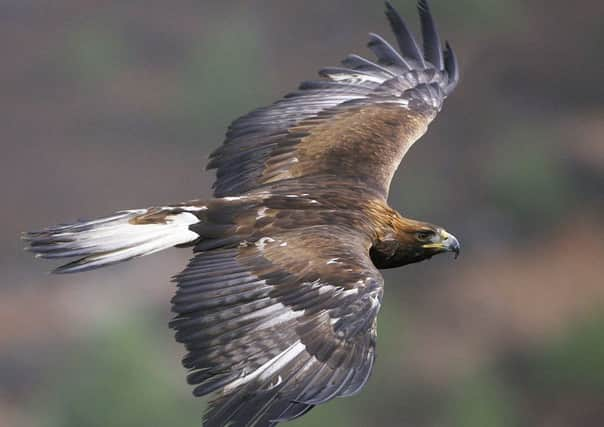Killing native birds mars landscape
This article contains affiliate links. We may earn a small commission on items purchased through this article, but that does not affect our editorial judgement.


THE sight of a golden eagle soaring over our fabulous Scottish landscape is a truly awe-inspiring spectacle and lives long in the memory.
The Gaelic scholar, piper and ornithologist, Seton Gordon, in his book The Golden Eagle first published in 1955, called it “the king of birds” and he describes the close links between this species and our landscapes and culture. In Seton Gordon’s day, the population of golden eagles in Scotland was estimated to be around 200 breeding pairs.
Advertisement
Hide AdAdvertisement
Hide AdHe noted that it had suffered several centuries of intense human persecution from game preservers and collectors. Some once-common species, like the sea eagle and the red kite, had also disappeared completely during this period, while other species including the golden eagle had seen their populations substantially reduced and pushed to the geographical margins.
Around the time that Seton Gordon was writing, the golden eagle and most other raptor species were afforded full legal protection in 1954, and later this protection was enhanced by the Wildlife and Countryside Act 1981. As a result of this legislation, and more enlightened views towards birds of prey, the fortunes of some of our native raptor species have improved. This population recovery is most notable in the lowlands where species like buzzards are now a common sight.
The current golden eagle population in Scotland is estimated to be about 440 breeding pairs, on the face of it a markedly improved situation. However, the Scottish Natural Heritage report A Conservation Framework for Golden Eagles, published in 2008, gave clear warnings to those who might be complacent about the fortunes of one of our most iconic bird species. This study showed that in the western Highlands, in landscapes dominated by sheep and deer grazing, many golden eagles had low productivity due to declines in their main prey species, particularly grouse and hares. In the eastern and central Highlands, and Southern Uplands, where much of the landscape is dominated by moors run for driven grouse shooting, golden eagles were still suffering in places from intense human persecution, and a good number of traditional nesting sites were vacant, despite high abundance of favoured prey.
In recent years the use of satellite telemetry has been deployed as a tool to better understand the dispersal and survival of young Scottish golden eagles. Small GPS tags weighing under 100g have been fitted by researchers under licence to young eaglets across Scotland. In early July 2011, I accompanied the accomplished Scottish bird artist and golden eagle enthusiast Keith Brockie to an eagle eyrie in Glen Lyon, Perthshire, where we fitted a satellite tag to an eaglet named Fearnan.
For nearly two years Fearnan was tracked around the central Highlands. In late 2013, Fearnan made a movement into the Angus glens, and into an area with a recent appalling history of reported crimes against birds of prey. Within days, the signals from the satellite tag were indicating that “Fearnan” might be dead, and indeed shortly afterwards his bedraggled corpse was retrieved by police and RSPB. He was later confirmed by Scottish Government toxicology analysis to have been illegally poisoned.
This disgraceful incident has rightly caused public outrage. There have been calls for the state licensing of Scottish grouse moors conditional on compliance with democratic laws designed to protect vulnerable raptor species. Scratch below the surface, and it is very clear to most knowledgeable observers that wildlife protection laws have had little impact in terms of population recovery of many of our native raptor species on land managed for driven grouse shooting. The hen harrier is almost extinct as a breeding bird on grouse moors, and peregrines also have little success in such areas.
RSPB research has shown that illegal activity on some grouse moors is also preventing the growth of the reintroduced red kite population from the Black Isle into Inverness-shire and Morayshire. There is increased scrutiny of ever more intensive and unsustainable management practices on grouse moors to achieve ever larger grouse bags for clients. Many grouse moors in Scotland seem bent on beating Victorian grouse bag targets.
These record grouse bags are achieved through the removal of mountain hares and red deer; as well as juniper and other scrub, which are implicated in the spread of tick-borne diseases to grouse; the medication of wild red grouse to prevent grouse diseases; as well as increased rotational burning of heather and consequent damage to peatlands and other habitats. In Scotland, we have some of the lightest touch regulation of hunting in the northern hemisphere. In the light of growing evidence of the scale of illegal killing of our native bird of prey species, together with other unsustainable land management practices, and the failure of self-regulation, there are inevitably greater calls for more substantive Scottish Government intervention.
Advertisement
Hide AdAdvertisement
Hide AdThe untimely death of Fearnan is sadly not an isolated incident, and should serve as a wake-up call to those who wish to see a more sustainable future in the way our landscapes are managed.
• Duncan Orr-Ewing is head of Species and Land Management at RSPB Scotland
SEE ALSO